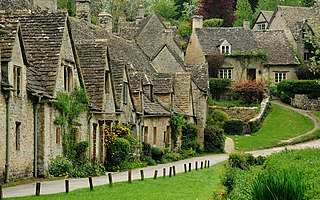
Gloucestershire is a ceremonial county in South West England. It is bordered by Herefordshire to the north-west, Worcestershire to the north, Warwickshire to the north-east, Oxfordshire to the east, Wiltshire to the south, Bristol and Somerset to the south-west, and the Welsh county of Monmouthshire to the west. The city of Gloucester is the largest settlement and the county town.

Cirencester is a market town and civil parish in the Cotswold District of Gloucestershire, England. Cirencester lies on the River Churn, a tributary of the River Thames. It is the eighth largest settlement in Gloucestershire and the largest town within the Cotswolds. It is the home of the Royal Agricultural University, the oldest agricultural college in the English-speaking world, founded in 1840. The town had a population of 20,229 in 2021. The town is 18 miles (29 km) northwest of Swindon, 18 miles (29 km) southeast of Gloucester, 37 miles (60 km) west of Oxford and 39 miles (63 km) northeast of Bristol.

Tewkesbury is a market town and civil parish in the north of Gloucestershire, England. The town grew following the construction of Tewkesbury Abbey in the twelfth century and played a significant role in the Wars of the Roses. It stands at the confluence of the River Severn and the River Avon, and thus became an important trading point, which continued as railways and, later, the M5 and M50 motorway connections were established. The town gives its name to the Borough of Tewkesbury, a local government district of Gloucestershire. The town lies on the border with Worcestershire, marked largely by the Carrant Brook.

Stroud is a market town and civil parish in Gloucestershire, England. It is the main town in Stroud District. The town's population was 13,500 in 2021.

Stroud District is a local government district in Gloucestershire, England. The district is named after its largest town of Stroud. The council is based at Ebley Mill in Cainscross. The district also includes the towns of Berkeley, Dursley, Nailsworth, Stonehouse and Wotton-under-Edge, along with numerous villages and surrounding rural areas. Over half of the district lies within the Cotswolds Area of Outstanding Natural Beauty.
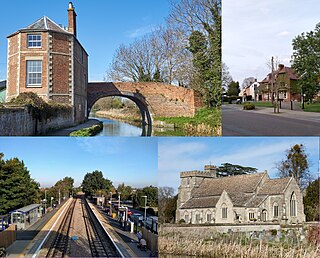
Stonehouse is a town in the Stroud District of Gloucestershire in southwestern England.

The River Frome, once also known as the Stroudwater, is a small river in Gloucestershire, England. It is to be distinguished from another River Frome in Gloucestershire, the Bristol Frome, and the nearby River Frome, Herefordshire. The river is approximately 25 miles (40 km) long.

Gloucester City Council is the local authority for the city of Gloucester, in Gloucestershire, England. Gloucester has had a council since medieval times, which has been reformed on numerous occasions. Since 1974 Gloucester has been a non-metropolitan district with city status.

Ebley is a community in Gloucestershire, England. It was once a village, and is now part of the Stroud urban area. It lies in the valley of the River Frome, 2 miles west of the town centre of Stroud. It is part of the civil parish of Cainscross.

Gloucester Guildhall is a former municipal building in Eastgate Street, Gloucester, which is now used as an arts and theatre venue. It is a Grade II listed building.
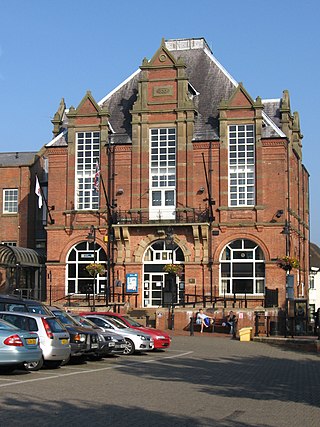
Ripley Town Hall is a municipal building in the Market Place, Ripley, Derbyshire, England. The town hall is the headquarters of Amber Valley Borough Council.

Aldershot Town Hall is a municipal building in Grosvenor Road, Aldershot, Hampshire, England. The town hall, which was the headquarters of Aldershot Borough Council, is a Grade II listed building.

Shipley Town Hall is a municipal structure in Kirkgate in Shipley, West Yorkshire, England. It was the headquarters of Shipley Urban District Council.
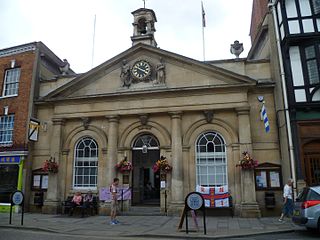
Tewkesbury Town Hall is a municipal building in the High Street in Tewkesbury, Gloucestershire, England. The building, which is the meeting place of Tewkesbury Town Council, is a Grade II* listed building.

Dursley Town Hall, also known as Dursley Market Hall, is a municipal building in the Market Place, Dursley, Gloucestershire, England. The structure, which is mainly used for markets and community events, is a Grade II* listed building.
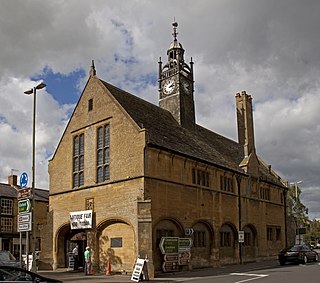
Redesdale Hall, also referred to as Moreton-in-Marsh Town Hall, is a municipal building in the High Street, Moreton-in-Marsh, Gloucestershire, England. The building, which is used as an events venue, is a Grade II listed building.

Tetbury Market House, also known as Tetbury Town Hall, is a municipal building in the Market Place, Tetbury, Gloucestershire, England. The building, which was used both as a market house and as a town hall until the late 19th century, is a Grade I listed building.

Painswick Town Hall is a municipal building in Victoria Square, Painswick, Gloucestershire, England. The building, which is used as an events venue and also as the offices of Painswick Parish Council, is a Grade II listed building.

Bewdley Guildhall is a municipal building in Load Street in Bewdley, Worcestershire, England. The structure, which is the meeting place of Bewdley Town Council, is a Grade II* listed building.

Mitcheldean Town Hall is a municipal building in the High Street in Mitcheldean, Gloucestershire, England. The structure, which operates as the offices and meeting place of Mitcheldean Town Council, is a Grade II listed building.





















